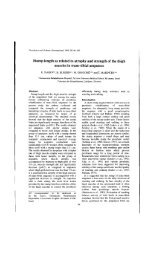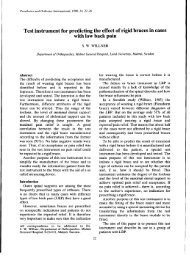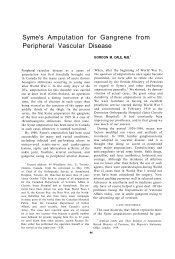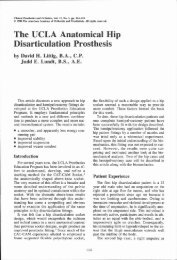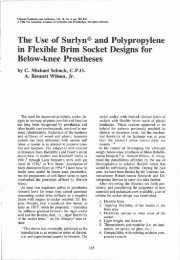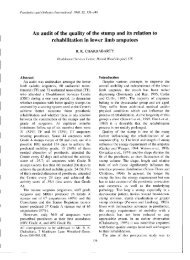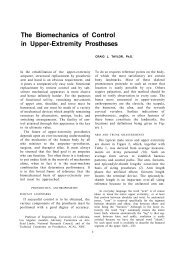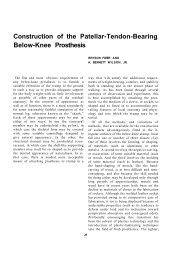Pro-Corn - O&P Library
Pro-Corn - O&P Library
Pro-Corn - O&P Library
You also want an ePaper? Increase the reach of your titles
YUMPU automatically turns print PDFs into web optimized ePapers that Google loves.
cedure, the prosthetist pulls the distal medial<br />
tissue in a lateral direction while stabilizing the<br />
femur with the other hand by means of a 45°<br />
force against the lateral shaft of the femur<br />
(Figure 10). Mr. Shamp stated that this centralization<br />
procedure is essential to prevent a large<br />
medial-distal bulge with resultant cosmetic<br />
problems when the femur is maintained in a<br />
position of maximum adduction in the AK<br />
prosthesis.<br />
Again, I will present an overview of the<br />
Shamp Narrow ML technique, summarizing<br />
from Mr. Shamp's presentation and from the<br />
"Manual for use of The Shamp Brim," which<br />
was provided for the workshop attendees. This<br />
manual was produced by <strong>Pro</strong>sthetic Consultants,<br />
Incorporated of Akron, Ohio in cooperation<br />
with the Department of <strong>Pro</strong>sthetics and Orthotics,<br />
New York University Post-Graduate<br />
Medical School, and is published by the Ohio<br />
Willow Wood Company.<br />
The measurement and evaluation procedure<br />
includes a careful observation and recording of<br />
the characteristics, lengths, and circumferences<br />
requested on the Narrow ML AK Information<br />
Chart. Review of this information chart will<br />
show the practitioner who is familiar with the<br />
technique for the quadrilateral socket that only<br />
a small number of measurements are different<br />
for the Narrow ML socket. It is important to<br />
note that three ML measurements must be<br />
taken precisely as follows:<br />
Figure 11. Distal Ischial Tuberosity (DIT), medial-lateral<br />
diameter measurement for Narrow<br />
ML Socket. 5<br />
1) Distal Ischial Tuberosity (DIT): firm ML<br />
measurement of the anatomy taken 1" to<br />
2" distal to the ischial tuberosity (Figure<br />
11).<br />
2) Oblique ML (OB): firm ML measurement<br />
taken from the medial side of the ramus<br />
of the tuberosity to a point just superior to<br />
the greater trochanter of the femur<br />
(Figure 12).<br />
3) Ischial Tuberosity ML (IT): firm ML<br />
measurement taken from the medial<br />
border of the ramus of the ischial tuberosity<br />
to the subtrochanteric area of the<br />
femur (Figure 13).<br />
The Shamp Brim, which is compatible with the<br />
Berkley brim stand, is now set up and adjusted<br />
to the patient's measurements. As stated earlier,<br />
the brim allows for weight-bearing evaluation<br />
of the patient with regard to socket design<br />
before the actual wrap cast is taken.<br />
As with all of the ischial-containment socket<br />
designs discussed at the Workshop, the location<br />
of the ischial tuberosity in the socket is essential<br />
to both a comfortable fit and a stable femur<br />
in maximum adduction. For the Shamp technique,<br />
the ideal location is 1/2" inside the medial-proximal<br />
wall of the prosthesis and indicates<br />
the area referred to as the IT ML measurement.<br />
The medial wall has a 45° angle that<br />
assists the wedge effect in stabilizing the femur<br />
and so the location of the tuberosity on this<br />
slope is important. The trimlines are similar to<br />
both NSNA and the UCLA CAT-CAM, including<br />
the low anterior wall with clearance for<br />
the ASIS, the relatively horizontal posterior<br />
wall, and the high lateral wall, which extends



